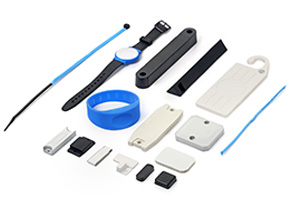
RFID systems consist of three components: an RFID tag or an RFID reader, and an antenna.
RFID tags contain an
integrated circuit and an antenna, which are used to transmit data to the RFID reader (also
called
an interrogator).
The reader then converts the radio waves to a more usable form of data.
Information collected
from
the tags is then transferred through a communications interface to a host computer system,
where
the
data can be stored in a database and analyzed at a later time.
An RFID tag is an electronic device about the size of a grain of rice. The tag contains an antenna and a microchip with data storage. When the antenna receives a specialized radio signal, the microchip "wakes up" and uses the antenna to send a message of its own. A tag can store up to 2 KB of data, far more than bar codes, which are also used to track items. Because the system uses radio waves, an RFID tag still works when embedded inside an object or packaged in a container. With the right radio signal, you can reprogram an RFID tag with new information, making it reusable and useful for a variety of tasks.

An RFID reader combines the functions of radio transmitter, receiver and data interface. The transmitter activates the tag, the receiver reads the tag's response and the interface passes information along to a computer or other equipment. The size and configurations of readers varies; some are handheld units, others are stationary, such as the theft detection devices at a retail store's exit. A stationary reader typically transmits its signal continually, waiting for a tag to pass within a few meters, at which point the tag sends its data.

A computer picks up the data sent to it by the RFID reader. The computer may display the tag's data directly, or it may look the data up in a larger, seperate database. For example, a factory uses RFID tags to keep track of car doors. When a truck delivers doors to the loading dock, a reader scans the tags and passes the information to a computer. The computer finds the tag's record in a database and marks the record as "received." When workers paint the doors, another reader scans the doors and marks their records as "painted." In this manner, the factory management can determine exactly how many doors it has, and how many are finished.

